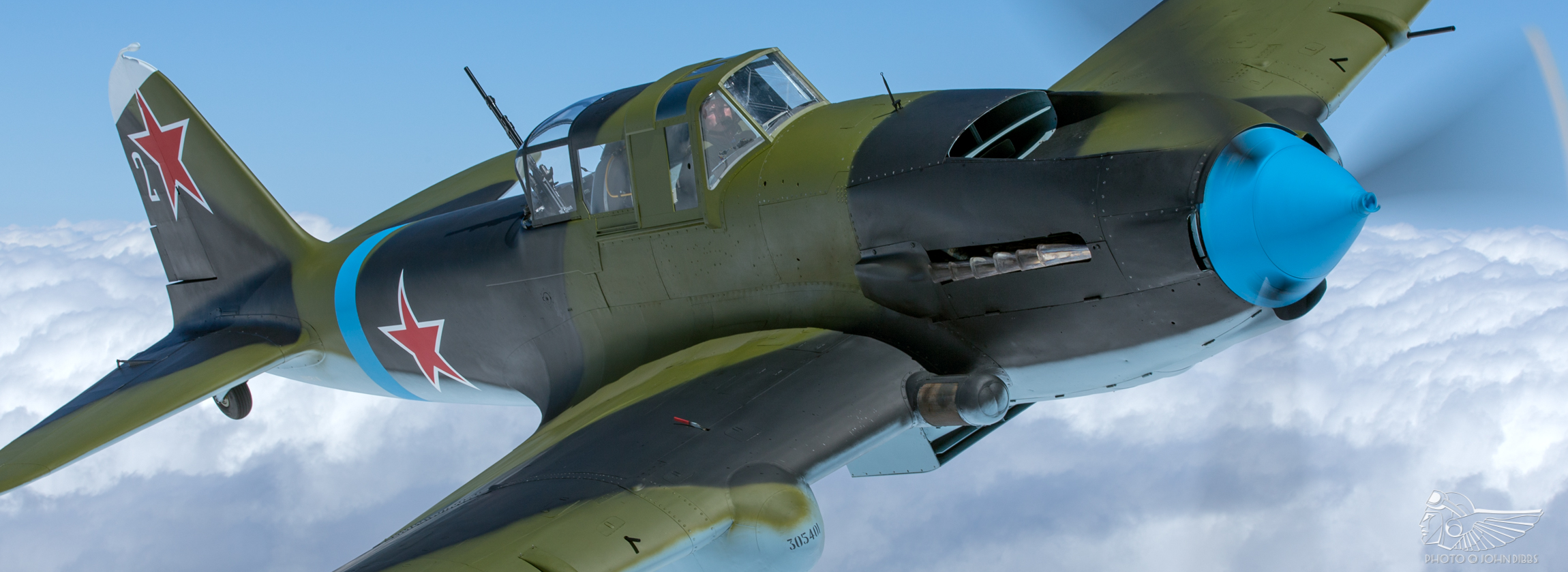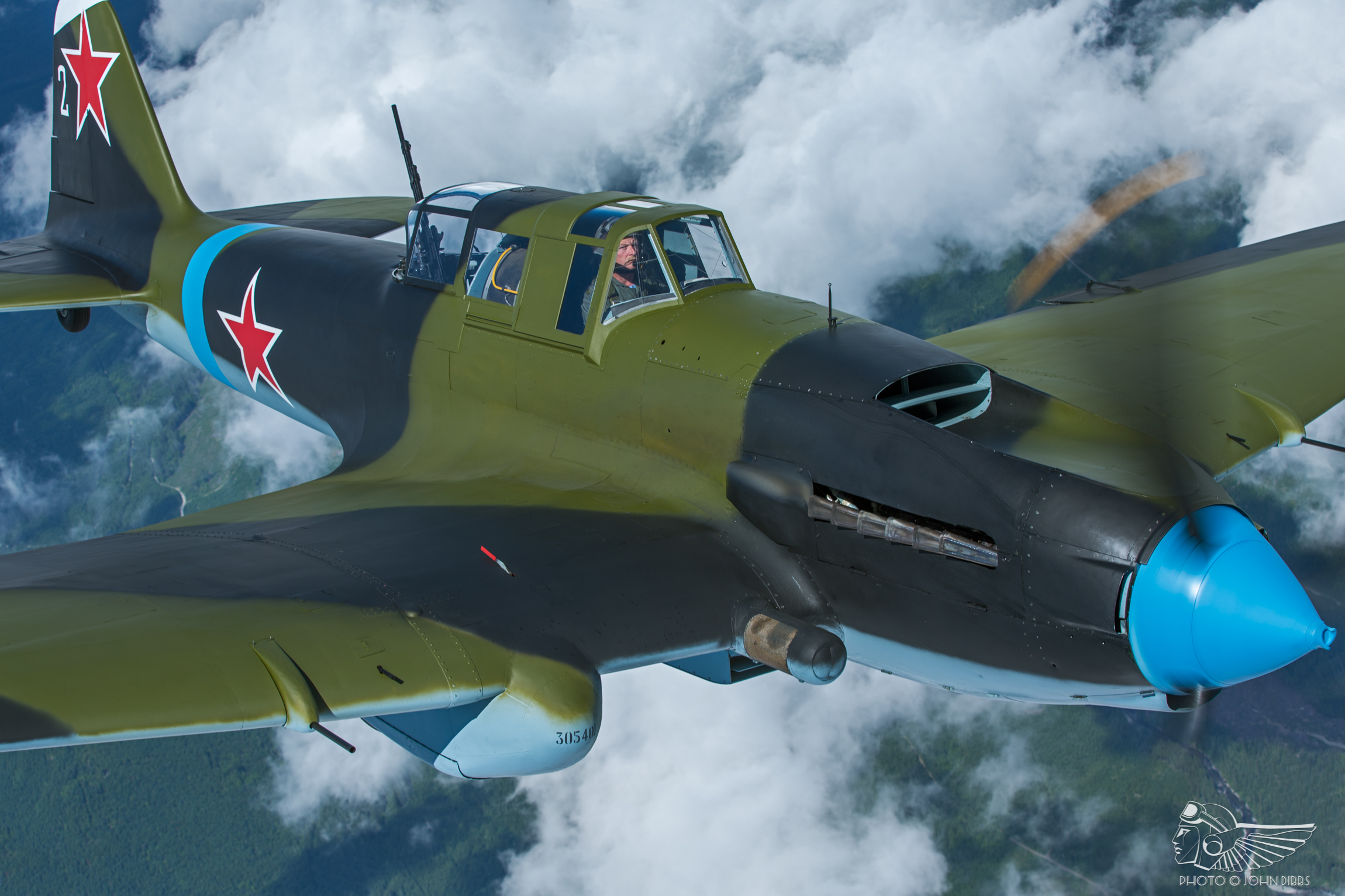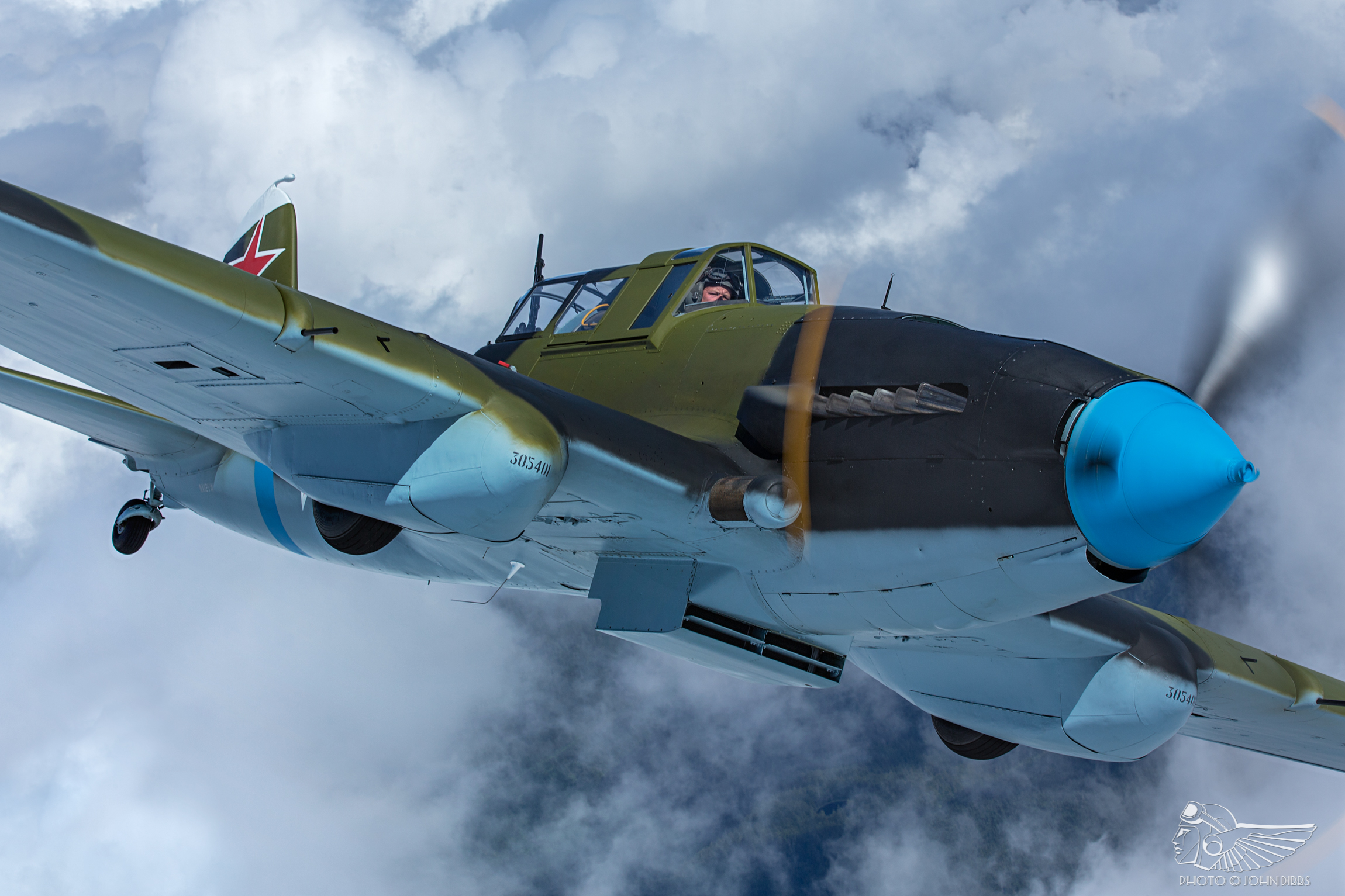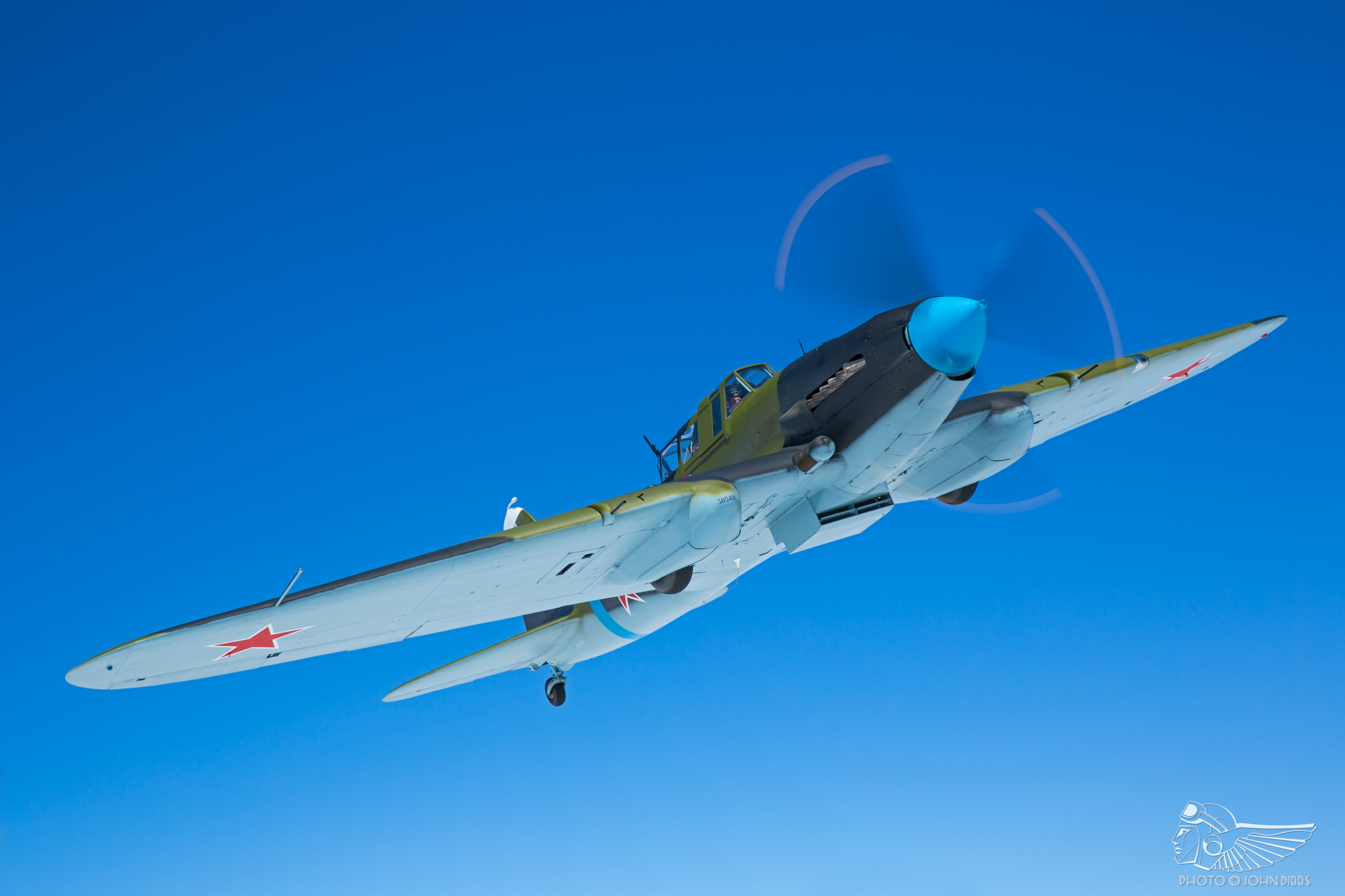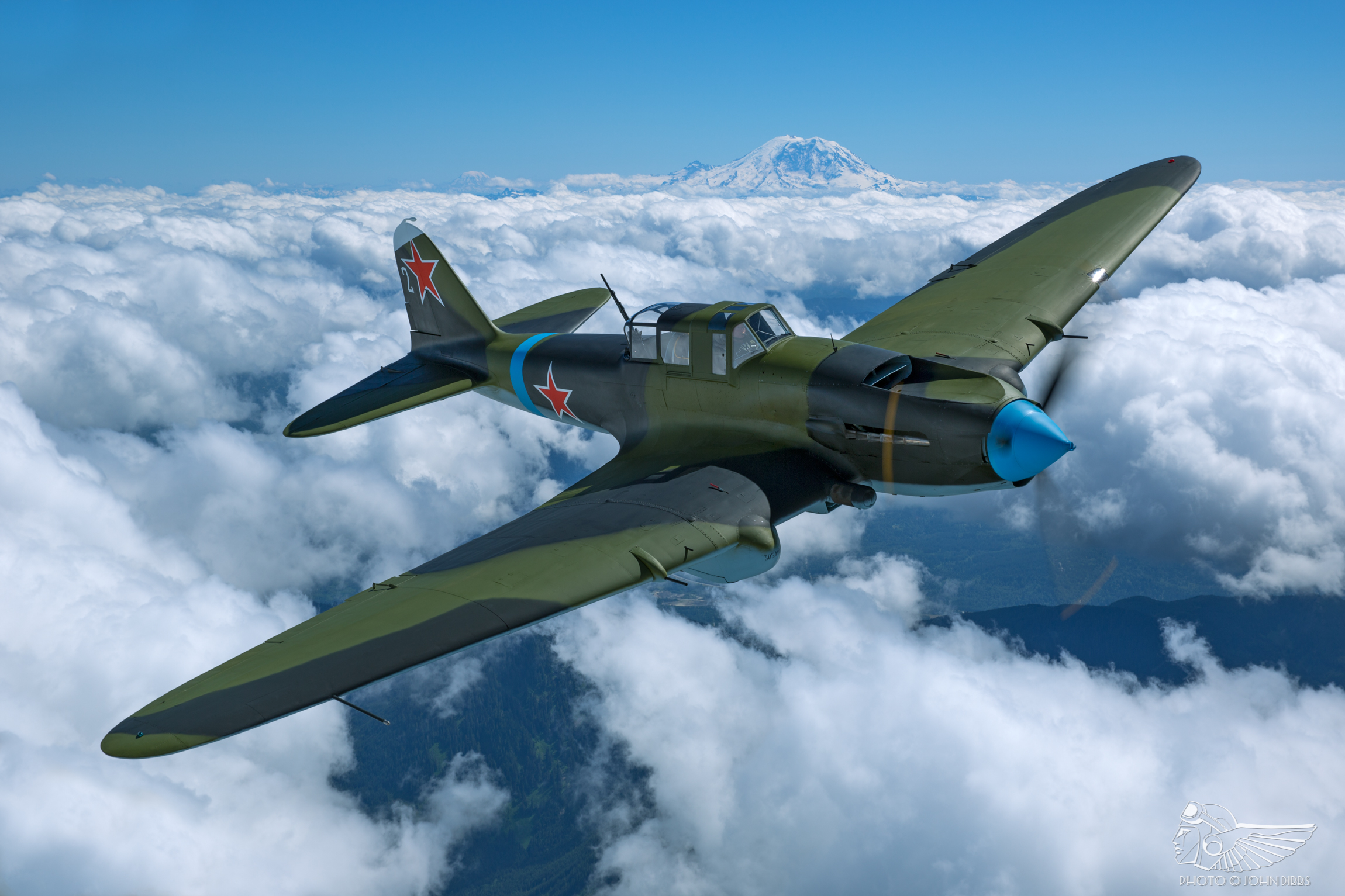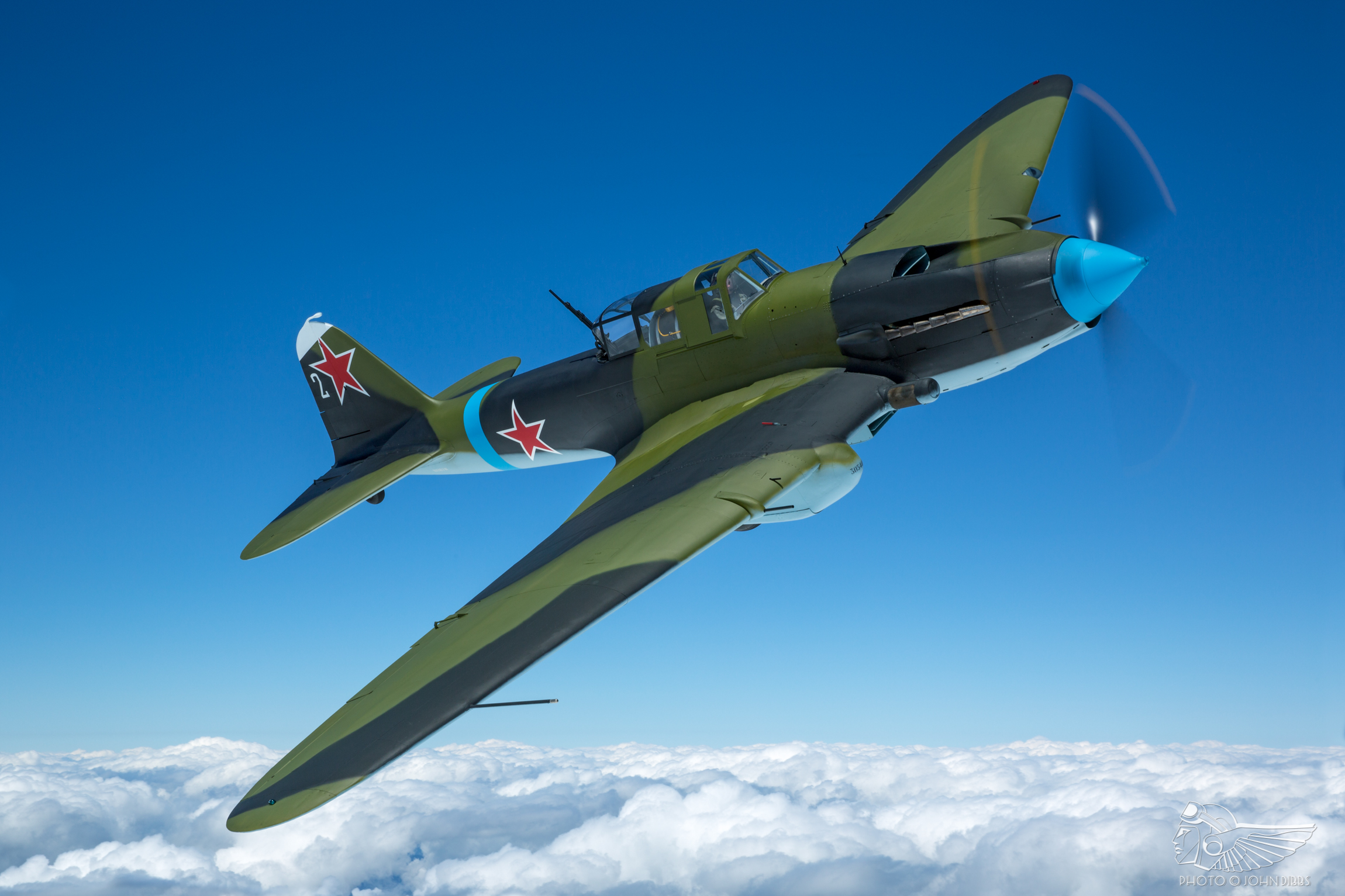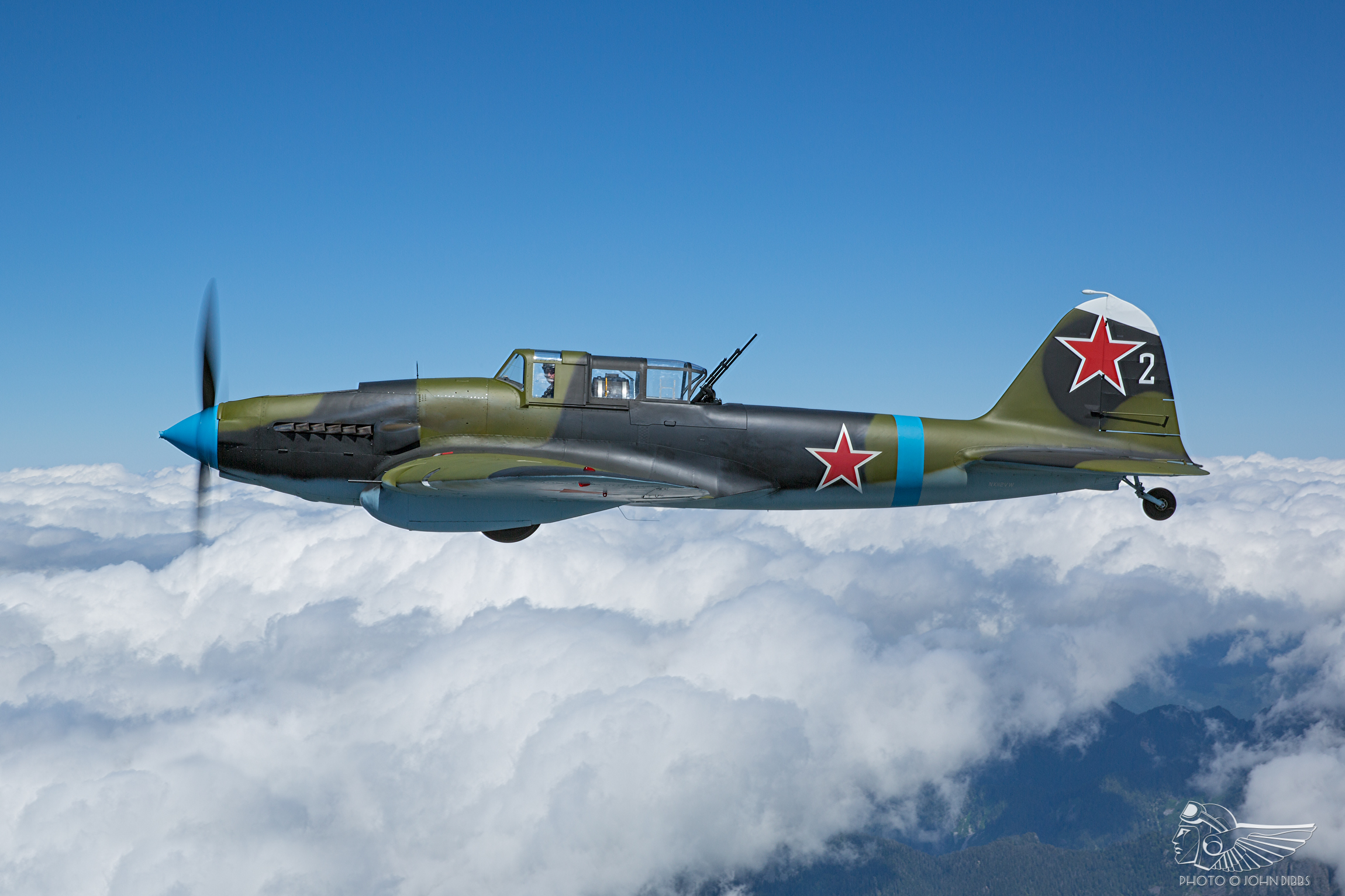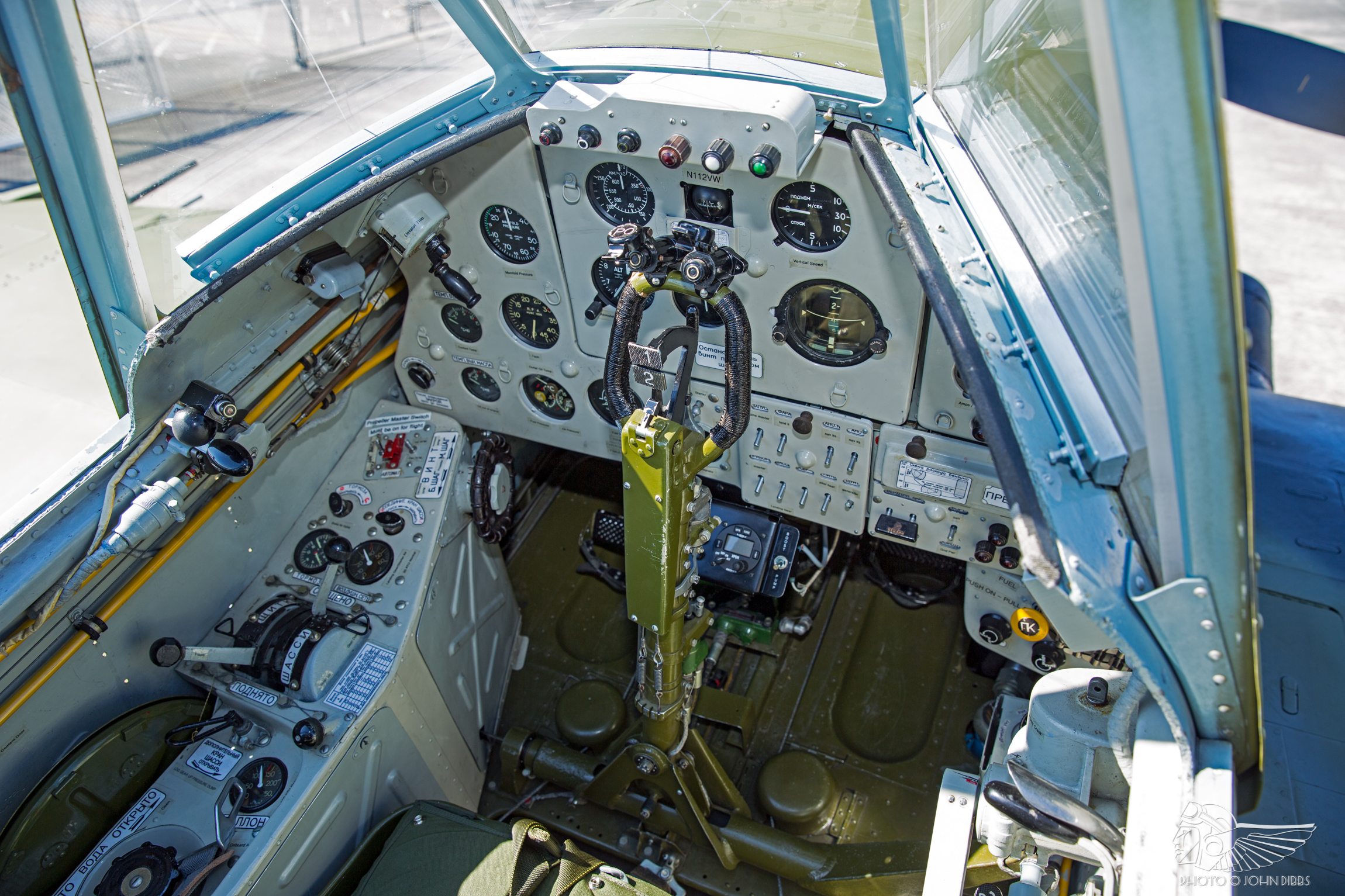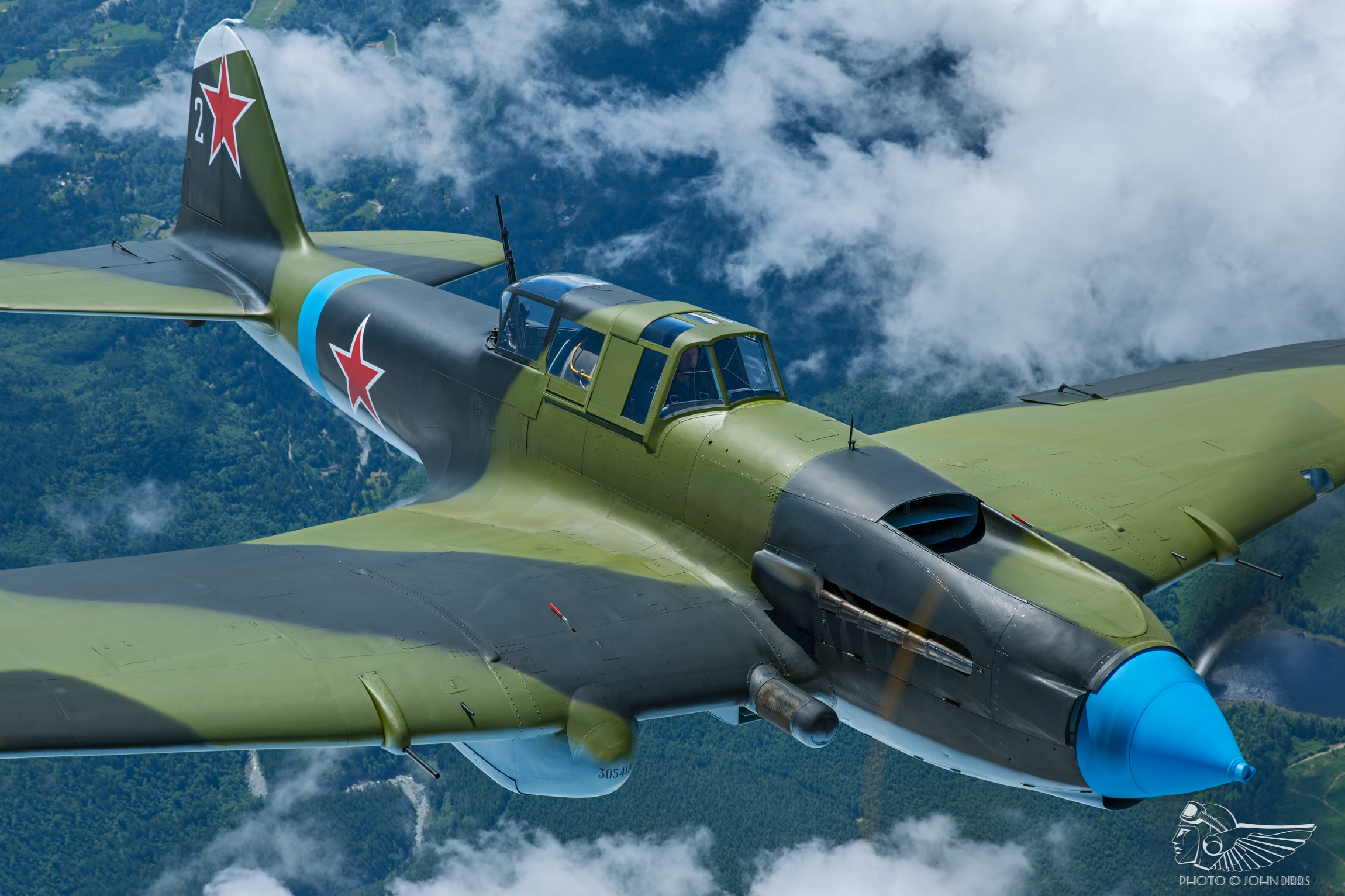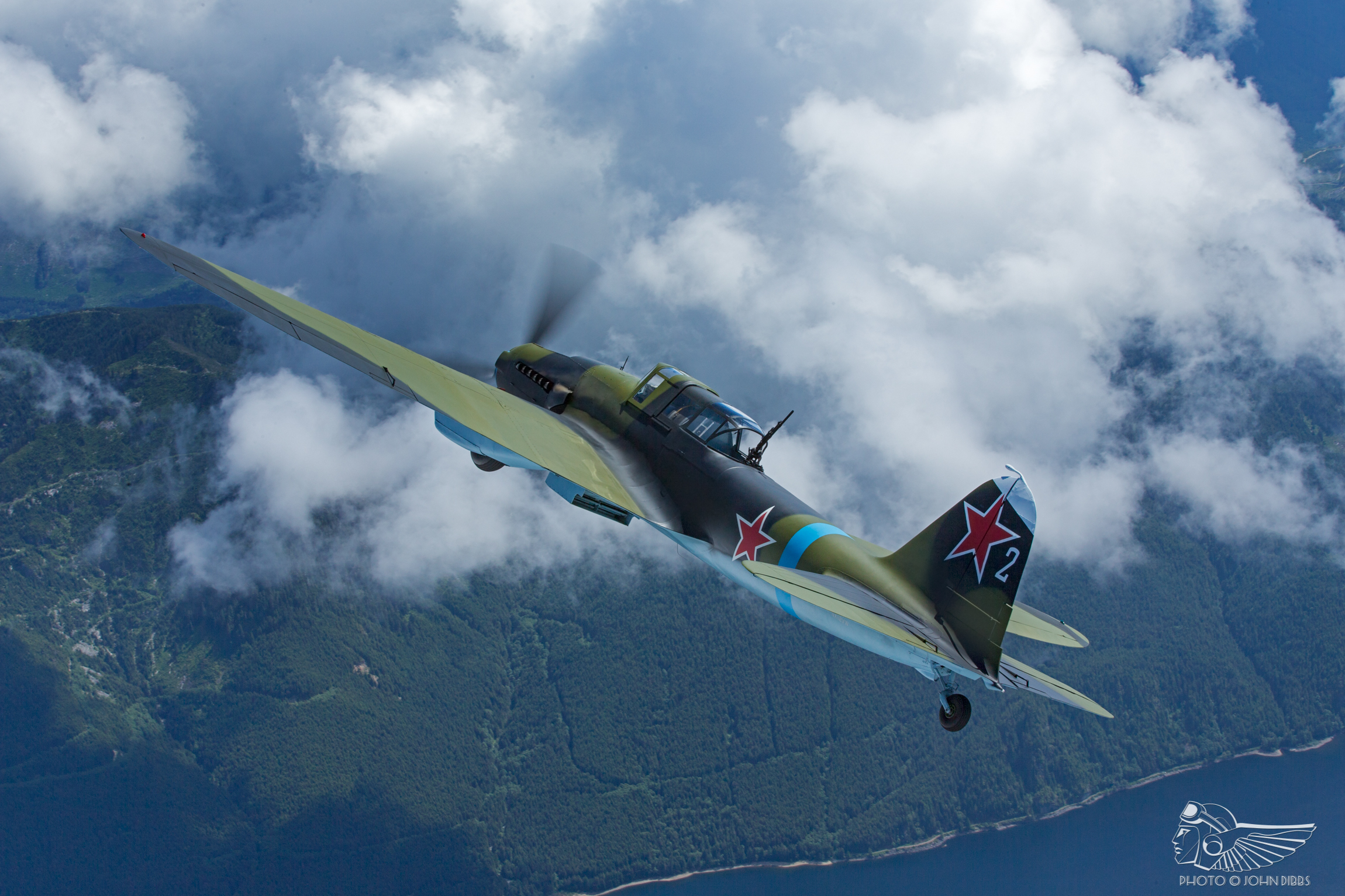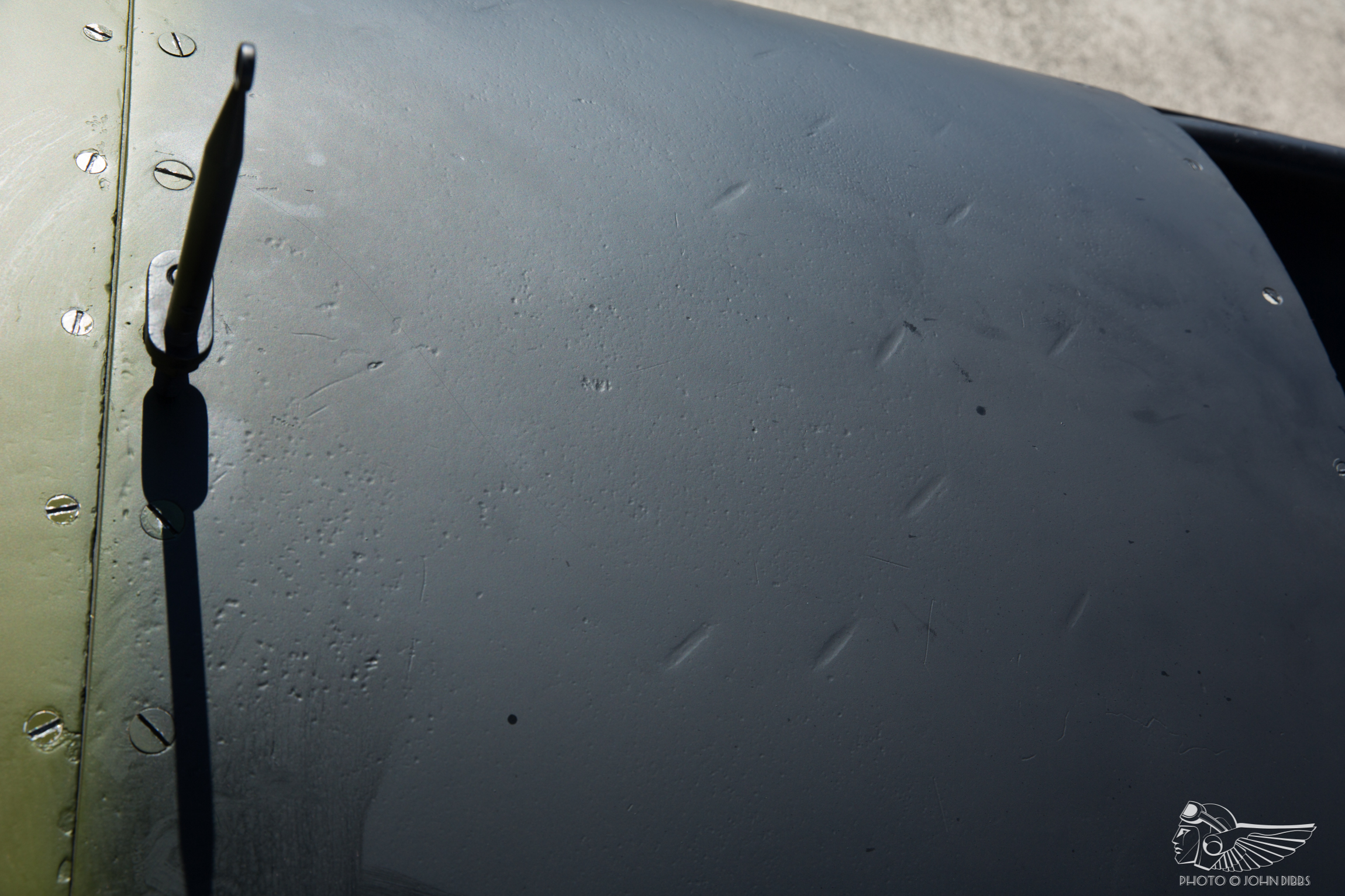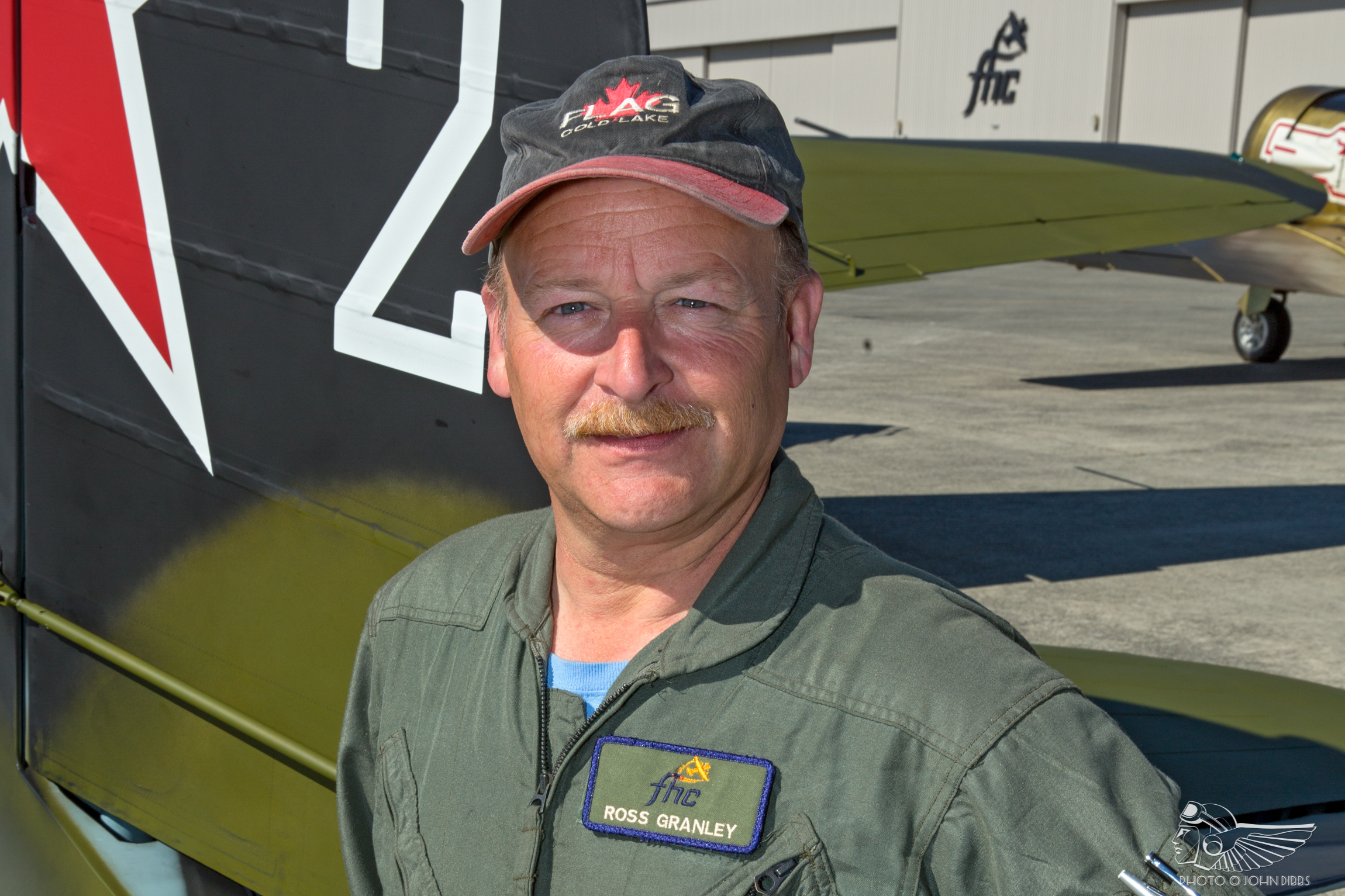Ross Granley is one of a distinguished few western pilots entrusted with flying the Ilyushin Il-2 Sturmovik, the first of just two airworthy examples of the type in existence. The aircraft is owned by Paul Allen’s Flying Heritage & Combat Armor Museum (FHCAM) at Paine Field, Washington and is one of the rarest Second World War aeroplanes flying today.
In this fascinating, in-depth assessment of the Il-2’s operation and handling characteristics, Ross offers The Vintage Aviation Echo a comprehensive account of flying the Sturmovik.
The Sturmovik first took flight in autumn 1939 and served extensively in the ground attack role with the Soviet Air Force on the Eastern Front from 1941-1945. By the time manufacturing ceased, the Il-2 and the up-rated Il-10 enjoyed the distinction of having the largest production run of any military aircraft design in aviation history, with more than 42,000 built.
The Sturmovik was renowned by the Soviets as a ubiquitous, potent close air support aircraft at the spearhead of the Soviets’ war-winning counter-offensive, its ability to soak up tremendous battle damage whilst reportedly destroying scores of tanks and sweeping the Germans from the countryside giving it an almost mythical aura. The Wehrmacht shared the sentiments, and accounts of destruction wrought by “Der Schwarze Tod” – “The Black Death” – from Stalingrad to Berlin itself preceded the Sturmovik.
FHCAM’s aeroplane is an Il-2M3, a conglomeration of four salvaged Il-2s with its identity taken from a Sturmovik manufactured in Kuybyshev in 1943 with c/n 305401. Tasked by the 828th Attack Aviation Regiment of the 260th Composite Air Division, the aircraft was downed by anti-aircraft fire whilst attacking an aerodrome on 10 October 1944 and crashed near the Titovka River, on the northern tip of Murmansk. Pilot K.P. Prohorov was fatally wounded and died in the crash, whilst the Il-2’s rear gunner, S.M. Semyonov, bailed out of the stricken aircraft at low-level and was killed. There the Sturmovik lay until recovery in 1991, its payload still mounted underwing after almost 50 years.
FHCAM commissioned the restoration in 2005, and construction began in an old fighter factory in south-western Siberia, utilising numerous original parts recovered from three other Sturmovik wrecks, including cockpit instruments, cockpit floor, undercarriage legs and parts of the cowlings and armour plating. The aircraft consequently bears signs of combat damage, its peppered cowling offering a vivid reminder of the perils faced by Sturmovik crews. The original Mikulin AM-38F engine was impractical to restore (no such engines are airworthy in the 21st century), and the aircraft was instead mated with a reliable Allison V-1710-113 engine, the same power plant used in the Lockheed P-38 Lightning.
After a lengthy rebuild, the Il-2 made its maiden flight in late September 2011, wearing the markings of twice-awarded Hero of the Soviet Union, Air Marshal Alexander Efimov, who had 126 tank ‘kills’ and seven air-to-air combat claims to his name whilst flying Il-2s. This marked the completion of one of the most significant historic aircraft restorations ever undertaken. Whilst Il-2 combat claims were largely overstated as was typical for the era, there’s no doubting that the Sturmovik’s exploits on the Eastern Front, and the ‘tank killer’ mythos that surrounds it to this day make it a true flying legend remembered with the same reverence as the British Spitfire and American Mustang.
Following completion of the Il-2’s test schedule, the aircraft was shipped from St Petersburg to FHCAM’s museum facility at Paine Field, Washington where it was flown for the first time in the west by Steve Hinton on 9 August 2012.
Alberta native Ross Granley was born into the very definition of an ‘aviation family’. He and his two brothers followed their father Bud into the Canadian Armed Forces (with Ross and one sibling joining the air force, the other joining the navy), whilst their sister pursued a different aviation career and went on to fly for Alaska Airlines. Ross instructed on the Canadair CT-114 Tutor, the diminutive jet trainer he flew extensively with the Snowbirds display team from 1990-1991, before undergoing his fast-jet conversion. In subsequent years Ross flew the CF-5 and the CF-188 in both air-to-air combat and low-level ground attack roles. After 12 years’ service and 3,100 hours’ flying time in the air force, Ross retired from the military and began flying for United Air Lines from Seattle.
In tandem, Ross has spent the last 20 years flying an imported Yak-18T alongside his father at airshows across North America and Canada in the dynamic Yak-O-Batics display team. The combination of complex aircraft experience and military disciplines acquired over a career spanning more than three decades, coupled with the operation of Russian-built vintage aeroplanes within an air display environment throughout a similar period, put Ross in good stead to become the third western pilot to fly FHCAM’s Sturmovik, after Steve Hinton and John Penney.
“The Il-2 was one of the key Allied aircraft in the Great Endeavour, and I was thrilled that FHCAM came to me and asked me to fly the aeroplane”, he recalls. “I had warbird experience flying FHCAM’s P-40 Warhawk and other similar types, and knowledge of Russian systems through flying Yaks -18, -52 and -55. Being able to understand Cyrillic script was a big help – getting into the cockpit for the first time didn’t feel too daunting. It’s humbling to be given that opportunity.
“The Il-2 is deceptive”, Ross continues, “and my enduring impression is that despite its size, you want it to be a fighter. You might be mistaken to think that it will fly similar to a P-47 Thunderbolt, but this is a very different animal and you’ve got to remind yourself that it’s a rugged bomber and adjust your mindset before flying it.” Accordingly, first impressions of the Sturmovik are that it is “a real monstrous beast” of a bomber – it presents quite the imposing mass of aeroplane when parked on the ramp. With a 47ft 11in wingspan covering vast 414ft², the Il-2 positively dwarfs the likes of the Messerschmitt Bf109 that would have engaged it in combat over the Eastern Front.
Stepping into the cockpit, Ross assesses the layout as fairly typical of Russian aeroplanes; “sparse, utilitarian, very manual and very mechanical, with bare minimum instrumentation, large levers and a towering control yoke with a standard spade grip”, he summarises. “I’m about 164cm and I’m always trying to keep the control column from hitting me in the chin when strapping in. My hands are up in front of my face when I’m flying the aeroplane, which is quite unusual.” Whilst cavernous, everything sits within easy reach, and with its simple systems and ergonomic layout, the Il-2 is in some respects one of the more straightforward Second World War combat aircraft to operate in the present day.
To initiate the reasonably simple start-up procedure, the battery is turned on and fuel pressure boosted using an electric booster pump (which replaces the manual wobble pump found in many aircraft of the era). With the propeller pitch set to ‘Automatic’, the pitch control wheel by the pilot’s left knee (not dissimilar in appearance to a trim wheel) is turned forward to place the prop in ‘full-fine’ for start-up. The vertical primer beside the pilot’s right knee is then unlocked and plunged downwards three times (the number of strokes varying with the engine temperature), with a preemptive fourth shot of fuel left in the open primer. Fuel mixture is opened for three seconds, and the throttle is cracked by a quarter of an inch.
The small magneto switches on the control panel immediately in front of the pilot at the bottom of the main instrument panel are both flicked on, and the metal T-shaped handle beside the magnetos is pulled forward a little less than an inch to start the engine. As the propeller begins to rotate, the mixture is edged forward slightly with the pilot’s left hand, and with his right, he has the option of a fourth prime in the event that the engine doesn’t fire with the first couple of propeller blade rotations. With the engine firing, oil pressure is monitored and 3 atmospheres desired within 5-10 seconds of start-up, otherwise the engine is shut down immediately.
The engine is initially warmed with the throttle advanced to achieve 700-800rpm, until an oil temperature of 40° and a coolant temperature of 60° are reached, after which the throttle is opened to 1,200rpm. Unlike a number of inline engine warbirds, overheating isn’t much of a concern for Sturmovik pilots and Ross explains that rather than keeping a watchful eye on the temperature gauges to ensure they don’t hit the red line, the more considerable challenge is ensuring that the engine is sufficiently warmed before take-off.
The pre-flight power checks see the throttle advanced to achieve an initial propeller pitch of 2,000rpm. At that rpm, the propeller control is taken out of ‘Automatic’ and an electronic blip switch on the instrument panel is used to run the pitch down to 1,600rpm, before propeller control is returned to ‘Automatic’. A slight mixture lean sees the pitch return to 2,000rpm, and both magnetos are then checked in turn for a variation inside 100rpm. Once this process has been concluded, the gauges should be showing an oil temperature of 50° and a coolant temperature of 80-90°; at this temperature, highly effective radiator and oil coolers are opened manually to maintain these numbers, and the tail wheel is unlocked using the lever on the right side of the cockpit in preparation for taxying, remaining so until lined up for take-off on the runway.
“If you haven’t figured out that you’re sat in a bomber, you’ll know as soon as you start taxying”, says Ross. “You need a lot of power and control input to move, but it can bite you if you overcook it so you treat it with a lot of care. There’s a great deal of mass to move and as soon as you get the nose moving one way to maintain forward vision, you need to be immediately applying full opposite rudder and tapping brake switch on the spade grip to control that swing, ’cause it’ll keep going.”
That care is typical of the approach taken by Ross and all of FHCAM’s highly experienced pilots. Whilst AM-38 powered Il-2s operated with take-off power of 50 inches’ manifold pressure during wartime, Ross’ sympathetic approach aims for a more conservative 42-45″ and 2,800rpm. Opening the throttle to just 50% travel provides maximum boost in the Il-2, thus attention is required during the take-off roll to avoid over-boost whilst concentrating on countering the torque with instinctive rudder input – “add a little bit, check your position, add a bit more, check the engine”.
Gentle, incremental throttle changes in the preliminary take-off roll require relatively minor rudder inputs compared with some western warbirds of a similar vintage – the rudder, Ross explains, adds considerable length to the fuselage and the notable torque-imposed swing can be countered through small taps of the rudder pedals. With the tail unsticking around ten seconds into take-off, Ross sets the aircraft at a seven degree attitude and lets the Il-2 fly itself off the ground at around 130km/h. The gear is raised immediately and retracts into the protruding bays built into the inner wing by the time the speed has increased to 170km/h. As the Il-2 lifts away from the airfield, Ross closes the throttle to climb power of 35-40″ (depending on the coolant and oil temperatures) and adjusts the propeller pitch to 2,600-2,800rpm in order to achieve a speed of 175km/h in the ascent.
Typical operation of the 1,475hp Allison engine maintains coolant temperatures at around 100°, with oil sitting at 50°, and in-flight operation of the radiator is usually only called for at a higher power setting. Even then, it takes a hot day for the engine temperatures to present anything of an issue. At cruise altitude, power can be reduced to an economic 22-23″ and 1,600rpm, which will see the Il-2 burning 25-28 gallons of fuel per hour. Ross finds that between 32″ and 2,300rpm and 40″ and 2,600rpm, the speed differential is only in the region of 20-30km/h, therefore “it’s not helpful to use more power in the Il-2”, he says, “so you can be very sympathetic cruising at speeds in the region of 270km/h. The engine is the key to these old aeroplanes”.
Once airborne, the Sturmovik’s “Winged Tank” moniker takes on a new meaning altogether. Whilst the aft fuselage is constructed of birch and pine plywood, the forward area of the fuselage is tremendously armoured to protect the pilot against enemy fire. The cockpit, engine and fuel tank all enjoyed the shrouding of up to 12mm of metal armour plating that could withstand small arms and cannon fire to the extent that Luftwaffe pilots recalled seeing their bullets merely bouncing off the metal, forcing a rethink in strategy.
Even the Il-2’s fuel tanks were protected in combat by pumping carbon dioxide into the tanks to fill the empty space; if a bullet or shell penetrated the fuel tank, the breach would be filled and the lack of fuel leakage and vapour prevented combustion. Accordingly, Luftwaffe pilots began targeting the Il-2’s weaker underside, aiming to damage or disable the vulnerable oil cooler by engaging the bombers from below and behind – a tactic taught by the Luftwaffe ‘aces’ operating over the Eastern Front to good effect.
One of the drawbacks of such extensive protection is the significant impairment of the pilot’s visibility. The canopy itself is protected by both the aforementioned armour and 65mm of protective glass, meaning that “laterally, there’s no visibility”, as Ross explains. “If I try to look over my shoulder the armour head plate blocks my view. To see my wingman, I have to lean forward the whole time, wrapping my body around one side of the stick to give myself a suitable angle to see to the rear. There’s only a small sliver you can use for rearward vision, which makes flying in formation difficult and I would imagine made an aerial combat situation more challenging too, particularly trying to evade enemy fighters”.
Key to handling the Il-2 effectively in-flight is the pilot’s appreciation of its dynamic instability – a quirk that makes manoeuvring the Sturmovik a challenge from the moment the aircraft is airborne until touch-down. Ross explains that the aircraft’s positive and negative pitch forces remain consistent at all speeds, a trait not dissimilar to the characteristics that made the Hawker Hurricane such an effective fighter during the early 1940s. “I’m working much harder to control the Il-2 than I work to control any other aircraft I’ve flown”, says Ross, whose logbook includes numerous Allied and Axis fighter aircraft including the Messerschmitt Bf109E, P-40 Warhawk and P-47 Thunderbolt. “It’s a docile aeroplane but it sure does focus your attention!
“The aeroplane is dynamically unstable and the pitch gets worse as you get slower”, he continues. “Once you have pitched away, positively or negatively, the aircraft keeps diverging. If I pitch up, the stick will, of its own accord, pull back towards me and I will immediately push it away to counter the pull. The pitch will become more pronounced as the speed bleeds off and is very aggressive approaching the stall. The aircraft stalls sedately at 105-110km/h, depending on weight, and with no tendency to depart sharply, but the pitch instability complicates matters.
“If I were to apply a small amount of power approaching the stall, I would need to simultaneously push the stick away from me; increase power rapidly and it’ll want to sit nose-high and will end up on its back very easily. With that in mind, I don’t want to get too slow over the top of a wingover in case I don’t have enough stick deflection to counter the pitch, so I will never pull the stick back beyond three quarters’ deflection in a vertical climb. As soon as the stick approaches three quarters’ deflection, which it can do all by itself without me applying any additional force, I will start heavily pushing it away from me to fight the pitch. On the descent from a wingover, the nose pitches down and I’ll be pulling back on the stick to counter that – it’s quite a ride!”
Coaxing the Il-2 through turning figures using the rudder also presents a challenge, and with such a large surface area to disrupt the airflow, the Sturmovik is equipped with a tremendously light and effective rudder. Full deflection can be made with virtually no force applied to the rudder pedals at any speed, which Ross says is quite different to most western aeroplanes where the requisite force increases with speed. “These are almost too well balanced”, he continues, “and you could overstress the tail using the rudder at speed if you’re not careful”.
By contrast, the Il-2’s ailerons are considerably less effective with strong longitudinal forces required to roll the aircraft, particularly at high speed. In a turning dogfight, Ross surmises that a pilot would likely be left with little option other than to dive to lower altitude and use the terrain for cover. The Il-2 can achieve its maximum velocity very rapidly in just a ten degree descent, and a careful combination of throttle and propeller pitch control throughout any climbing and diving figures is essential. “You have to keep to shallow dives to avoid overspeeding”, says Ross, “and as soon as I enter any kind of diving figure I will bring the throttle back to 25-28″ and adjust the propeller pitch to 2,000rpm to ensure it isn’t running too fast with too little pressure in the engine”.
Propeller control in the Il-2 is not particularly precise, and Ross assesses that it takes large inputs to the control wheel to change the rpm, requiring the pilot to “feed” the wheel to adjust pitch in-flight. “You gain manifold pressure as you lose altitude and the propeller can overspeed if you aren’t vigilant; it’s a careful balance to maintain. I don’t think the Il-2 would have been able to have maintained a particularly steep bank in a combat situation without overspeeding. I would imagine those aircraft were overstressed in combat most of the time, particularly when utilised as dive bombers. I would image they may have been more effective as strafers for that reason.”
In the landing pattern, Ross flies a standard curved approach typical of all tailwheel warbirds, and deploys the flaps after having broken into the ciruit. The Il-2’s flaps operate in two stages using a pneumatic blow-down system, whereby the first stage can be deployed from 175km/h and the second stage follows below 140km/h. There is no blow-up system in place to retract the flaps if the aircraft exceeds those limitations, and care must be given not to overstress them at higher speeds.
Dropping the second stage of flap at lower-level produces a pronounced downward pitch oscillation at slow speed, which Ross avoids by bringing the Il-2 back at higher altitude in the circuit and dropping full flap so as to counter the pitch before reaching critical altitudes. As the speed bleeds off to 150km/h at around 300ft in the turn, Ross will be working to control the considerable adverse yaw with the rudder all the way down to the deck, typically touching down at around 120km/h.
“I try to land it slightly tail high and fast”, Ross continues, “to protect the plywood monocoque structure. We inspected the tail wheel after the first couple of flights and found that some of the glue had been cracking – there should have been more of a cut out to allow flex around the bulkheads. To mitigate against this I elected to land a touch fast on the main undercarriage with the tail low, to avoid unnecessary stress on the monocoque. We’ve since found out it’s not a problem, but it’s better to take care of the structure.”
Ross’ ground attack experience gives him an interesting perspective of the Sturmovik’s handling qualities. “I feel comfortable in the Il-2 down near the ground”, he muses. “The docile stall is a tremendous asset for a bomber, and the armour plating would be wonderfully protective for a pilot. Up high, though, I’d be worried. It’s a bomber – it doesn’t manouevre very well, and doesn’t have the power to evade vertically. I wouldn’t want to get into a turning dogfight with it.” In a one-on-one melee with a lighter, faster and more agile German interceptor, the Il-2 could easily find itself on the losing end of an engagement and indeed, many aircraft were lost in such a manner and Il-2 crews suffered severe casualties.
Il-2s were tremendously well armed for ground attack operations, with bombs, rockets, 23mm cannon and 7.62mm machine guns all brought to bear on ground targets which typically included tanks, armoured vehicles, trucks, parked aircraft and troop concentrations. Whilst its forward-facing cannon (300 rounds) and machine guns (1,800 rounds) provided a measure of hope in the event that the Sturmovik could manouevre itself onto an enemy fighter’s tail, rearward defence relied on an aft facing gunner armed with a single 12.7mm (.50cal) UBT machine gun. The pivotal rear gunner was afforded just 6mm of armour protection, effective only against small arms fire, and his legs sat exposed within the plywood monocoque.
“I would be a very unhappy camper back there”, says Ross. “The gunners were fastened in with a canvas strap that was harnessed to the sides and bottom of the fuselage, but they were not restrained in any fashion outside that strap and had no real defence against enemy fire. Tremendously brave, those men.
“All the conflict it was involved in, and until very recently it was the only one flying”, reflects Ross. He remains one of just a handful of pilots who have the distinction of flying the Il-2 and the ability to appreciate in peace time the qualities and vices of a true piece of military history. “I deem it a great honour and a pleasure to be given the opportunity to fly it. It’s a unique aircraft in many ways, but it isn’t something you can’t work with – there’s no great secret to it.
“It’s a tremendous privilege to be able to do it.”
![]()


